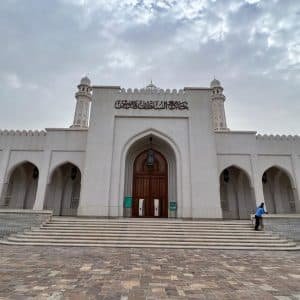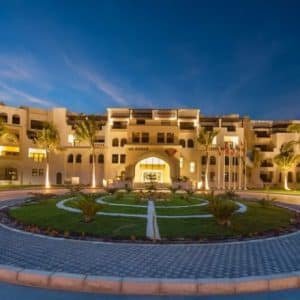Sultan Qaboos Mosque Salalah Guide: 20 Reasons Why This Majestic Mosque is a Must-Visit
Sultan Qaboos Mosque Salalah Guide
The Sultan Qaboos Mosque Salalah guide introduces you to one of Oman’s most breathtaking religious structures and an unmissable highlight of any trip to Salalah. Named after the late Sultan Qaboos bin Said, Oman’s beloved leader, this mosque is a glowing symbol of Islamic faith, Dhofari identity, and modern Omani architecture.
Located in the city center, the mosque combines white marble grandeur, lush green domes, and exquisite Islamic patterns with spiritual tranquility. It is not just a house of prayer, but a national treasure that reflects Oman’s cultural dignity and architectural excellence.
Where Is Sultan Qaboos Mosque Salalah Located?
The mosque is centrally positioned on 23 July Street, Salalah’s main boulevard, making it highly accessible by foot, taxi, or private car.
📍 Google Maps Coordinates: 17.0199° N, 54.0871° E
⛪ Nearby Landmarks:
Salalah Central Market
Sultan Qaboos Youth Complex for Culture & Entertainment
Al Hosn Palace (royal compound)
Architectural Marvel of Sultan Qaboos Mosque Salalah
The mosque’s architecture is a fusion of tradition and modern elegance. Its white exterior shines under the southern sun, while lush gardens surround the compound, offering both visual and spiritual peace.
Design Elements
Three green domes, each featuring intricate lattice and gold-trimmed crescents
Two symmetrical minarets that rise like watchtowers over the city
Grand arched entryways made of marble and stone
Intricately designed windows with floral Islamic motifs
Interior Wonders
A spacious main prayer hall that accommodates up to 3,200 worshippers
Persian carpets, chandeliers, and hand-carved mihrab that accentuate elegance
Cool marble flooring and air-conditioning for comfort year-round
A serene women’s prayer area that mirrors the same artistic detail
Spiritual and Cultural Significance
Built to honor the legacy of Sultan Qaboos bin Said, the mosque reflects not only his devotion to Islam but his vision of national unity and architectural beauty.
The mosque hosts:
Five daily prayers
Friday sermons that address local and global Islamic topics
Special Ramadan prayers, including Taraweeh and Qiyam-ul-layl
Eid prayers attended by hundreds of local worshippers
Visitor Information and Etiquette
The mosque is open to both Muslims and non-Muslims, provided visitors respect cultural norms.
| Requirement | Details |
|---|---|
| Dress Code | Men: long pants; Women: headscarf, long sleeves, full length dress or abaya |
| Entry Times | Best to visit between prayers, ideally mid-morning |
| Photography | Allowed in open spaces; avoid photographing people during prayer |
| Shoes | Remove before entering the prayer halls |
| Quietness | Maintain respectful silence inside the mosque |
What to See Inside the Mosque
Mihrab: A beautifully carved prayer niche indicating Qibla (Mecca direction)
Minbar: The elevated pulpit used for Friday sermons
Chandeliers: Sparkling crystal chandeliers suspended from the domes
Marble Columns: Supporting arches decorated with symmetrical floral motifs
Each detail within the mosque tells a story of devotion, discipline, and design—hallmarks of Omani spiritual identity.
Sultan Qaboos Mosque Salalah Guide for Travelers
This mosque offers an exceptional photography opportunity, especially during:
Sunrise – light reflecting off marble tiles
Sunset – golden glow over the domes and minarets
Night – under gentle illumination
📸 Tip: Use a wide-angle lens to capture the full prayer hall or exterior façade. The mosque is especially striking when framed with its gardens.
Best Time to Visit Sultan Qaboos Mosque Salalah
October to April: Cooler weather, perfect for a relaxed visit
Ramadan Evenings: Full of spiritual energy, though more crowded
Weekdays (Morning to Noon): Least crowded and best light for photos
Ramadan at Sultan Qaboos Mosque Salalah
Ramadan transforms the mosque into a hive of nightly devotion:
Taraweeh prayers are led with beautiful Qur’an recitation
Local families gather outside the mosque for Iftar
Late-night prayers stretch past midnight during the final 10 nights
Nearby Attractions to Combine With Your Visit
| Location | Distance from Mosque | Highlight |
|---|---|---|
| Al Hosn Palace | 5 mins | Royal architecture (viewable from outside) |
| Salalah Central Market | 3 mins | Spices, frankincense, textiles |
| Al Haffa Souq | 15 mins | Traditional Omani shopping |
| Museum of the Frankincense Land | 20 mins | Oman’s trade and maritime history |
FAQs
Is the mosque open to non-Muslims?
Yes, outside of prayer times. Dress modestly and follow etiquette.
Can I take a guided tour?
While official tours aren’t always available, locals and security staff are helpful and welcoming.
Are women allowed inside?
Yes. A dedicated prayer area is available. Visitors should wear a headscarf and modest attire.
Is photography allowed?
Yes, in most areas—but avoid photos of worshippers without consent.
Is parking available?
Yes, there’s ample on-site and nearby parking.
Conclusion: Why Sultan Qaboos Mosque Salalah Deserves a Spot on Your Itinerary
The Sultan Qaboos Mosque Salalah guide highlights a place where faith meets artistry. From its majestic domes to its spiritual ambiance, this mosque embodies Oman’s values of peace, elegance, and devotion.
Whether you’re a worshipper, cultural enthusiast, or curious traveler, a visit to this mosque offers more than a glimpse into Islamic tradition—it offers a moment of serenity in Salalah’s vibrant heart.









Comment (0)